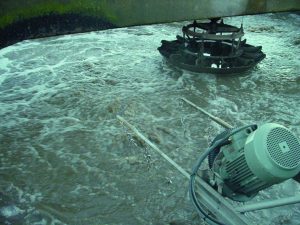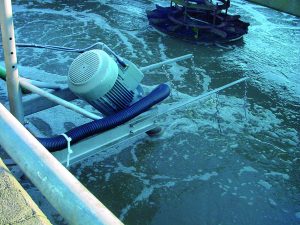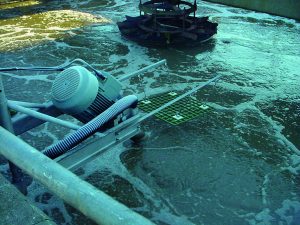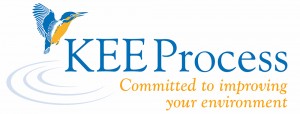The wastewater treatment plant at the village of Keith in Aberdeenshire treats municipal wastewater from the village and effluent from a famous branded Whisky Distillery nearby.
The overall process on site includes inlet works with a grit chamber and screen for municipal wastewater. After this preliminary treatment, the municipal wastewater stream is mixed with the Distillery effluent and is processed through the first-stage high-rate biofilter tower. The effluent from the biofilter tower is then processed through radial flow-scraped primary settlement tanks and the settled effluent is discharged into a two-stage activated sludge basin consisting of two tanks of 7.92m x 7.92m x 4.65m deep (water depth 3.65m). The mixed liquor from the activated sludge plant is discharged through to three radial flow-scraped final settlement tanks and the settled effluent is discharged to a watercourse. The settled sludge is returned (RAS) to the activated sludge basin with excess sent to sludge storage. Finally, supernatant from the sludge storage tank is returned to the feed for the high rate filter tower.
The aeration system for the activated sludge basin consists of two surface-mounted aerators driven by a 20kW common-geared motor through a propshaft delivering approximately 30kg/hour of dissolved oxygen.

EXISTING AERATION SYSTEM – ONLY ONE SURFACE AERATOR OPERATING
The total BOD load to the plant from municipal and industrial sources is 570 kg/day and approximately 285kg of this is reduced through the high rate biofilter and the remaining 285kg/day is required to be treated through the activated sludge plant. The aeration tank capacity is 230m3 each and is normally operated at MLSS concentration of approximately 2000mg/l. One of the surface aerators in the existing aeration system had failed and a temporary venturi aeration system was installed to assist in oxygen supply.
KEE were requested to visit the site, analyse the situation and evaluate the process requirements to make a proposal to upgrade the aeration system. The factors to be taken into account included the need to upgrade the aeration system whilst the plant continued to operate (without decommissioning the plant) and to ensure that the new aeration device produced less than 60dB noise. KEE evaluated the existing process parameters and concluded that the plant could be operated at a higher MLSS concentration of up to 4000 mg/l at a substrate loading rate of 0.15g BOD/g MLSS. The estimated dissolved oxygen demand on this basis would be approximately 33kg/hour.
KEE proposed to install four 5.6kW dual mode Triton processors to provide complete mixing of both the aeration basins and to supply up to 40kg/hour of dissolved oxygen. The Triton dual mode processor is an efficient aeration device which provides total (horizontal and vertical) mixing of the whole basin. It can be mounted from a wall or a bridge or can be supported from floats. The Triton can mix up to a depth of 10m and therefore is also ideal for upgrading existing aeration systems for total replacement or supplemental aeration. The Triton uses a low-power regenerative blower for air supply and a direct-coupled electric motor to generate a plume of fine bubble aeration which is able to penetrate through to the bottom of the tank. This air/water mixer provides a long retention period for air bubbles and the resulting high efficiency oxygen transfer into the mixed liquor. By EPA definition the Triton is a fine bubble aerator.

KEE TRITON® AERATION IN OPERATION
The four Tritons were mounted from the side walls of the existing tanks and, once all the installation work was completed over two days, the electrical cabling was finalised. The blowers supplying air into the Triton were controlled through D.O. probes located in the aeration basin. Once all the electro mechanical work was complete the Tritons were switched on and the old aeration system switched off. The plant aeration system upgrade was achieved in less than one week’s time on site and without any downtime on the existing treatment process. There was no need to hire temporary plants to relieve activated sludge plant. Apart from large savings in capital and operating costs, the biggest benefit was that all the logistics and space problems associated with installing a temporary plant were avoided. The noise emitted by the new aeration system is much lower than specified and definitely lower than the previous system. The process performance of the plant has improved and the plant is able to meet its specified process objectives and has continued to do so for over twelve months.
For more information visit the KEE website.


